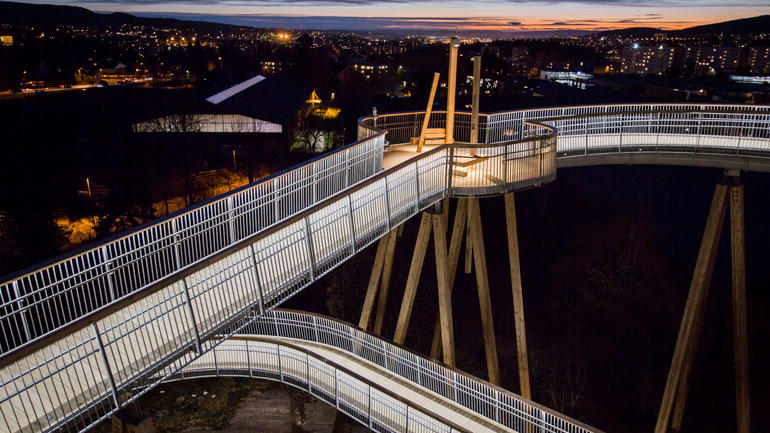Master in Architectural lighting design – Light and Lighting for Life
Kongsberg - Part time
Take a part-time master’s degree to get new insights and learn innovative techniques in the field of architectural lighting design. The degree offers you opportunities for new career paths while meeting the needs for innovation and sustainability both in the industry and wider society
-
Closing dates: Expired
Study facts
-
Campus: Kongsberg -
Study level: Master’s degree -
Progression of study: Part time -
Start up: Not defined -
Teaching model: Session-based -
Credits: 120 -
Charge: 29.500 NOK per semester (total 236.000.-) There will be an additional semester fee. -
Closing dates: Expired -
Semesters: 8 -
Teaching Language: English
Tuitions and seminars
USN’s master’s degree in architectural lighting design is a part-time, online- and seminar-based programme that you complete in parallel with your professional work. You retain your experience, income and network in the industry while at the same time having the opportunity to update your knowledge and acquire new academic skills.
Student seminars usually take place in Kongsberg or on the premises of an actor or actors working in the sector in Oslo. Some of the seminars are held digitally, involving lectures, group work, mentoring and online presentations.

Why a master’s degree in architectural lighting design?
Technological advances, combined with a growing interest in sustainable development, light pollution, health and design processes, have generated a need for greater levels of skills and expertise among future professional lighting designers. The future demands highly qualified professionals with training in both design and scientific methods.
USN’s master’s programme offers you the opportunity to progress to an advanced level. You will be able to continue with your career at the same time as following the study programme offered by the university.
The programme is intended for architects, engineers, designers, lighting designers and others looking to improve their skills in the field of lighting design.
This master’s degree offers new and updated knowledge that reinforces cross-disciplinary collaboration. Students will work together, and with their lecturers and mentors, with the aim of identifying effective solutions to light- and lighting-related challenges faced by wider society. They will receive training in a variety of academic and design processes and will be given the opportunity to engage in active reflection about their work in dialogue with others. This is why the physical seminars are so important. The students’ physical presence in the various lighting labs is essential for the observation of light and colour phenomena, the performance of various light measurements, and exposure to problems linked to perception and visual impression.
The knowledge and skills acquired during this master’s programme in lighting design contribute to economic, social and ecological sustainability.
Light and Lighting for Life
We have nicknamed the master Light and Lighting for Life. This refers to the fact that:
- Light and lighting are central to human health, well-being and well-being.
- We want to contribute to continued biological diversity and minimal negative light effects on ecological systems.
- We want living and sustainable cities where people thrive, where we can facilitate activity and social interaction even in the dark seasons.
What you will learn
USN’s master’s programme in architectural lighting design is a cross-disciplinary study combining elements of lighting design and architecture, engineering, technology, system engineering, optometry, urbanism and health. It offers answers to future sustainability needs by focusing on the following four fields of research and development:
- Sustainable light strategies
- Design and innovation
- Light and psychology; light and biology
- Knowledge-based practice and academic design
USN’s master’s programme in architectural lighting design is a design-oriented study that promotes the development of innovative approaches and sustainable solutions by means of critical thinking and academic design. Students will utilise both scientific and design methods to acquire an advanced understanding of relevant overlapping fields and disciplines. The programme provides you with the skills you need to address the many different challenges that the future will bring. Students will learn to use design and design processes to identify creative and intelligent lighting solutions. As a student, you will learn to engage in critical and reflective practice, both alone and in discussion and group work with your fellow students.
Where can I work?
This master’s programme offers you the professional maturity, skills and expertise that will qualify you for senior technical and management positions in the design sector.
Contact with business and industry
We collaborate with international academic institutions from Alto, TUDelft, Wismar, Aalborg and Jönköping and KTH in Sweden.
Personnel from the lighting sector network organisation Lyskultur, the professional association Norske lysdesignere, as well as major consultancies and suppliers, will contribute to the programme as lecturers and student mentors. Students will be taken on visits to actors within the sector and some seminars will be held on their premises. It will be possible to write your master’s thesis in collaboration with one or more actors within the sector. In this way you will be able to establish an extensive network within the industry.
Further studies
The master's degree is eligible for doctoral studies in person-oriented health work at the University of Southeast Norway or at other universities. If you do not want to take a full master degree, it is possible to take individual subjects from the programme.
Admission requirements
A bachelor’s degree or equivalent. There is also a requirement for two years of relevant work experience in the fields of architecture, design, an engineering discipline or similar.

